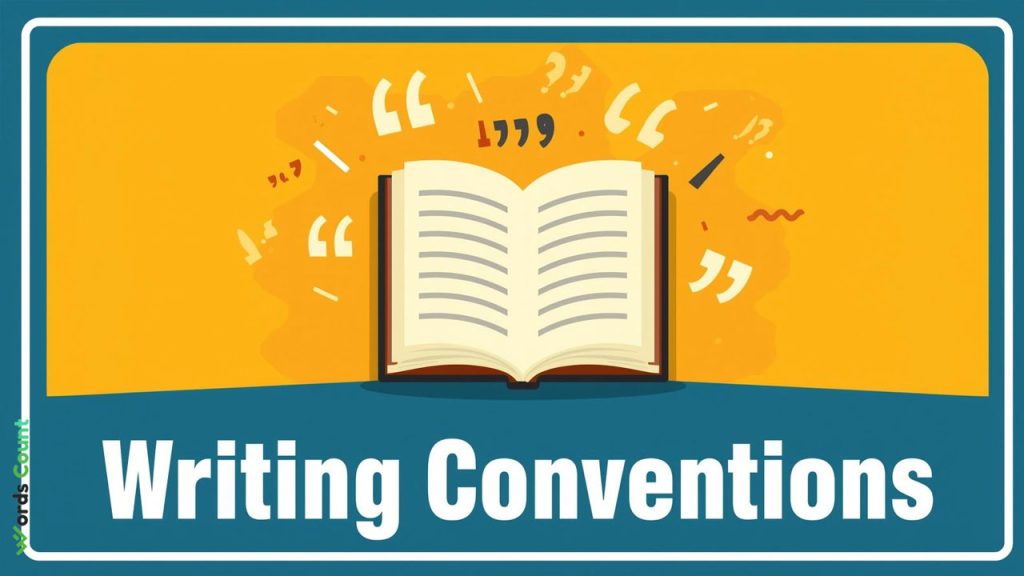Writing is like building a house. You need a solid foundation, strong walls, and a good roof to make it work. In writing, those building blocks are called conventions. These are the rules and habits that help your writing make sense to everyone who reads it. Whether you’re penning a story, an essay, or a note to your friend, conventions are your best buddies. They make sure your ideas are clear, your sentences flow, and your readers aren’t scratching their heads. Let’s dive into what writing conventions are, why they matter, and how you can use them to make your writing awesome.
What Are Writing Conventions?

Writing conventions are the standard ways we write to share ideas clearly. Think of them as the “rules of the road” for writing. Just like you follow traffic lights to drive safely, you follow conventions to write effectively. They cover things like grammar, punctuation, spelling, sentence structure, and formatting. When you use these rules, your writing looks polished and professional, and it’s easier for others to understand.
Why do these rules exist? Well, imagine if everyone wrote however they wanted, with no periods or capital letters. It’d be chaos! Conventions create a shared language that connects writers and readers. They’re not about being strict or boring—they’re about making sure your awesome ideas don’t get lost in a jumble of words.
Why Conventions Matter
Conventions are important because they help your writing do its job: communicate. Without them, your reader might get confused or give up on your story. Here’s why sticking to conventions is a game-changer:
Clarity: Proper grammar and punctuation make your ideas easy to follow.
Professionalism: Good conventions show you care about your work.
Engagement: Well-written sentences keep readers hooked.
Trust: Correct spelling and formatting make your writing seem reliable.
For example, if you’re writing a letter to your teacher, using proper conventions shows respect and helps your teacher focus on your message, not your mistakes.
Benefit | How It Helps |
|---|---|
Clarity | Makes ideas easy to understand |
Professionalism | Shows you take your writing seriously |
Engagement | Keeps readers interested in your words |
Trust | Builds confidence in your writing |
Types of Writing Conventions

There are a few main types of writing conventions that work together to make your writing shine. Let’s break them down so you can see how each one helps.
Grammar: The Backbone of Writing
Grammar is like the skeleton of your writing—it holds everything together. It’s the rules for how words fit together to make sentences. For example, using the right verb tense (like “I run” instead of “I running”) makes your writing clear. Grammar also includes things like subject-verb agreement, where you match singular subjects with singular verbs, like “The dog barks” instead of “The dog bark.”
Good grammar keeps your writing from sounding like a jumbled puzzle. For instance, instead of saying, “Me went to store,” you’d say, “I went to the store.” It’s a small change, but it makes a big difference in how your reader understands you.
Punctuation: The Traffic Signs of Writing
Punctuation marks are like traffic signs—they tell your reader when to pause, stop, or get excited. Periods, commas, question marks, and exclamation points guide your reader through your sentences. For example, a comma can separate ideas in a list, like “I bought apples, bananas, and oranges.” Without that comma, your list might look messy or confusing.
Here’s a quick look at some common punctuation marks and what they do:
Punctuation Mark | Purpose |
|---|---|
Period (.) | Ends a sentence |
Comma (,) | Separates ideas or items in a list |
Question Mark (?) | Shows a question |
Exclamation Point (!) | Adds excitement or emphasis |
Using punctuation correctly keeps your writing smooth and easy to read. Imagine reading a book with no periods—it’d feel like a runaway train!
Spelling: Getting the Words Right
Spelling is super important because even one wrong letter can change the meaning of a word. For example, writing “there” instead of “their” can confuse your reader. Spellcheck tools are great, but they don’t catch everything, so it’s good to double-check tricky words.
Spelling mistakes can make your writing look sloppy, even if your ideas are amazing. To avoid this, try reading your work out loud or asking a friend to check it. Also, keep a list of words you often misspell so you can practice them.
Capitalization
Capitalization is the use of uppercase letters at the beginning of sentences, for proper nouns, and in other specific places. It helps distinguish important words in your writing, making it easier to follow.
Examples of proper capitalization:
The first letter of a sentence: “I went to the park.”
Proper nouns like names of people, places, or things: “I visited Paris last summer.”
Sentence Structure: Building Strong Sentences
Sentence structure is about how you put words together to make sentences that make sense. A good sentence has a subject (who or what the sentence is about) and a predicate (what the subject does). For example, in the sentence “The cat sleeps,” “the cat” is the subject, and “sleeps” is the predicate.
You can mix up your sentence structure to keep things interesting. Use short sentences for impact, like “The dog ran.” Then, add longer sentences to explain more, like “The dog ran across the park to chase a bright red ball.” This variety keeps your reader engaged and makes your writing fun to read.
Paragraphing
Paragraphs are used to break up your writing into manageable chunks. Each paragraph should focus on a single idea or point. Proper paragraphing makes it easier for readers to follow your argument or story.
For example:
Without paragraphs: “I went to the store to buy some bread. The bread was fresh and soft. I also bought milk because I needed some for my coffee.”
With paragraphs: “I went to the store to buy some bread. The bread was fresh and soft.
I also bought milk because I needed some for my coffee.”
Breaking up the writing into paragraphs makes it more organized and easier to understand.
Consistency
Consistency in writing means keeping the same style, tone, and voice throughout your work. This includes consistent use of tense, point of view, and formatting. When writing is inconsistent, it can confuse the reader.
For example, if you switch between past and present tense without reason, it can make your writing hard to follow. Consistency helps the reader stay on track with your ideas.
Clarity
Clarity refers to how easily your writing can be understood. Clear writing uses simple, direct language to get the point across. Avoiding overly complex sentences and words makes your writing more accessible to your readers.
For example:
Clear writing: “I went to the store to buy bread.”
Unclear writing: “In order to satisfy my need for some essential nourishment, I ventured to the local market to purchase a loaf of bread.”
The first sentence is much clearer and easier to understand.
Formatting: Making Your Writing Look Good
Formatting is how your writing looks on the page. It includes things like paragraphs, headings, bullet points, and fonts. Good formatting makes your writing easy to skim and understand. For example, breaking your writing into short paragraphs with clear headings (like the ones in this article) helps readers find what they’re looking for.
When formatting, think about your audience. If you’re writing for school, use double-spaced text and a standard font like Times New Roman. If you’re writing a blog, use bold headings and bullet points to make it reader-friendly.
Formatting Element | Why It’s Useful |
|---|---|
Paragraphs | Break up text for easier reading |
Headings | Organize ideas and guide the reader |
Bullet Points | Highlight key points clearly |
Fonts | Make text readable and professional |
How to Use Conventions in Different Types of Writing
Conventions aren’t one-size-fits-all. The way you use them depends on what you’re writing. Let’s look at how conventions change depending on the type of writing you’re doing.
Stories and Creative Writing
In stories, conventions help you paint a picture with words. Grammar and punctuation keep your story clear, but you can bend some rules for effect. For example, you might use short, choppy sentences to create suspense, like “The door creaked. Footsteps echoed. She froze.” Spelling and formatting, like using italics for thoughts, can add personality to your story.
Essays and School Papers
For schoolwork, conventions are super important because teachers expect clear, polished writing. Stick to proper grammar, use complete sentences, and follow formatting rules like double-spacing or citing sources. For example, in an essay, you’d write, “The American Revolution began in 1775,” not “American Revolution start 1775.”
Emails and Letters
When writing emails or letters, conventions show respect and professionalism. Use proper greetings like “Dear Ms. Smith” and close with “Sincerely, [Your Name].” Keep sentences clear and avoid slang. For example, instead of “Yo, what’s up?” you’d write, “Hello, how are you?”
Tips for Mastering Writing Conventions
Learning writing conventions takes practice, but it’s totally doable. Here are some easy tips to help you get better:
Read a Lot: Reading books, articles, and stories shows you how good writers use conventions. Notice how they use commas, start paragraphs, or structure sentences.
Practice Writing: Write every day, even if it’s just a short journal entry. The more you write, the better you’ll get at using conventions.
Use Tools: Try grammar-checking tools like Grammarly or spellcheck in Google Docs. They catch mistakes you might miss.
Ask for Feedback: Show your writing to a teacher, parent, or friend. They can point out where your conventions need a little love.
Learn One Rule at a Time: Don’t try to master everything at once. Focus on one thing, like using commas correctly, then move to the next.
Tip | How to Do It |
|---|---|
Read a Lot | Check out books or articles daily |
Practice Writing | Write a short story or journal entry |
Use Tools | Try Grammarly or spellcheck |
Ask for Feedback | Share your work with a trusted person |
Learn One Rule | Focus on one convention at a time |
Common Mistakes and How to Avoid Them
Even great writers make mistakes, but knowing what to watch out for can help. Here are some common convention slip-ups and how to fix them:
Run-on Sentences: These happen when you cram too many ideas into one sentence. For example, “I went to the park and I saw a dog and it was cute.” Fix it by breaking it into smaller sentences: “I went to the park. I saw a dog. It was cute.”
Misused Commas: Putting commas where they don’t belong can confuse readers. For example, “I like to eat, apples, and bananas” is wrong. The right way is “I like to eat apples and bananas.”
Spelling Errors: Words like “definitely” (not “definately”) trip people up. Double-check tricky words or use a dictionary.
Inconsistent Formatting: Mixing fonts or spacing can make your writing look messy. Stick to one style, like 12-point Arial, throughout your work.
By watching out for these mistakes, you can make your writing cleaner and more professional.
Why Conventions Make You a Better Writer
Using conventions doesn’t just make your writing clear—it makes you a better writer overall. When you follow these rules, you focus on your ideas instead of worrying about mistakes. Conventions also help you connect with your readers, whether they’re your teacher, your friends, or people online. Plus, they give you confidence. When you know your writing looks good, you’re more likely to share it with the world.
Think of conventions as tools in your writing toolbox. The more you practice using them, the sharper they get. Pretty soon, you’ll be writing stories, essays, or emails that make people say, “Wow, this is awesome!”
FAQs About What Are Conventions in Writing
What are writing conventions?
Writing conventions are the standard rules for grammar, punctuation, spelling, sentence structure, and formatting that make writing clear and professional.
Why are writing conventions important?
Conventions help your writing make sense, keep readers engaged, and show that you care about your work.
How can I improve my grammar?
Read a lot, practice writing daily, and use tools like Grammarly to catch mistakes. Focus on one grammar rule at a time to improve.
What’s the difference between grammar and punctuation?
Grammar is about how words fit together to make sentences, while punctuation uses marks like commas and periods to guide the reader.
Can I break writing conventions?
In creative writing, you can bend some rules for effect, like using short sentences for suspense. But in school or professional writing, stick to the rules for clarity.
How do I know if my formatting is good?
Good formatting uses clear headings, short paragraphs, and consistent fonts. Ask someone to read your work to see if it’s easy to follow.
What’s the easiest way to avoid spelling mistakes?
Use spellcheck tools, read your work out loud, and keep a list of words you often misspell to practice them.
Final Words
Writing conventions are like the secret sauce that makes your writing tasty. They’re not here to make your life harder—they’re here to help your ideas shine. By using proper grammar, punctuation, spelling, sentence structure, and formatting, you can create writing that’s clear, engaging, and professional. Whether you’re writing a story, an essay, or an email, conventions are your guide to getting your message across. So, grab a pen, start practicing, and watch your writing skills soar!
